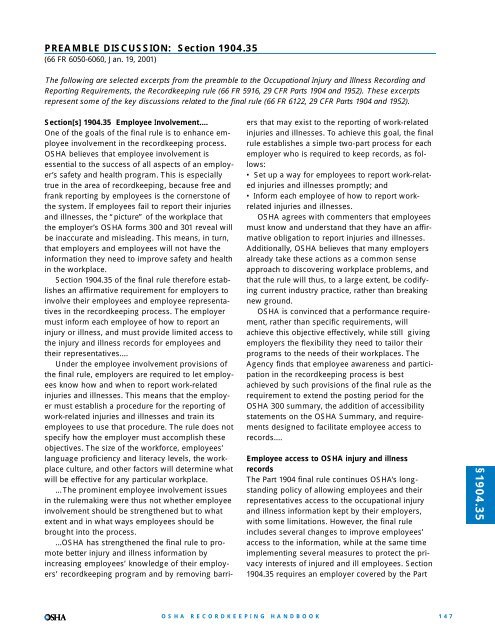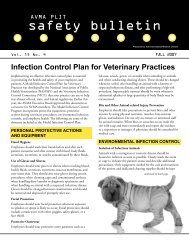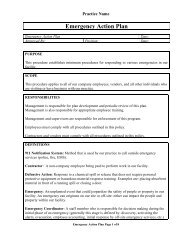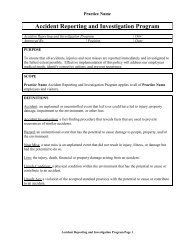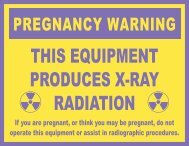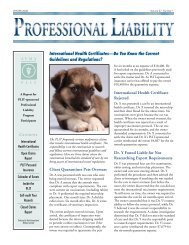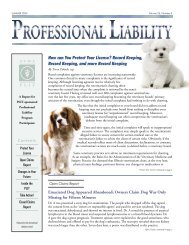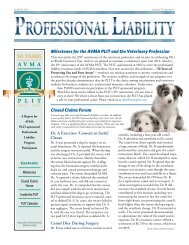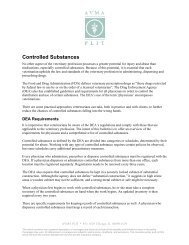Section 1904.35Employee involvement(66 FR 6132, Jan. 19, 2001)REGULATION: Section 1904.35Subpart D – Other <strong>OSHA</strong> injury and illness recordkeeping requirements(66 FR 6130, Jan. 19, 2001)§1904.35(a) Basic requirement.Your employees and their representatives must beinvolved in the recordkeeping system in several ways.(1) You must inform each employee of how he orshe is to report an injury or illness to you.(2) You must provide limited access to your injuryand illness records for your employees and their representatives.(b) Implementation.(1) What must I do to make sure that employeesreport work-related injuries and illnesses to me?(i) You must set up a way for employees to reportwork-related injuries and illnesses promptly; and(ii) You must tell each employee how to reportwork-related injuries and illnesses to you.(2) Do I have to give my employees and their representativesaccess to the <strong>OSHA</strong> injury and illnessrecords?Yes, your employees, former employees, theirpersonal representatives, and their authorizedemployee representatives have the right to accessthe <strong>OSHA</strong> injury and illness records, with some limitations,as discussed below.(i) Who is an authorized employee representative?An authorized employee representative is anauthorized collective bargaining agent of employees.(ii) Who is a “personal representative” of anemployee or former employee?A personal representative is:(A) Any person that the employee or formeremployee designates as such, in writing; or(B) The legal representative of a deceased orlegally incapacitated employee or former employee.(iii) If an employee or representative asks foraccess to the <strong>OSHA</strong> 300 Log, when do I have toprovide it?When an employee, former employee, personalrepresentative, or authorized employee representativeasks for copies of your current or stored<strong>OSHA</strong> 300 Log(s) for an establishment the employeeor former employee has worked in, you mustgive the requester a copy of the relevant <strong>OSHA</strong>300 Log(s) by the end of the next business day.(iv) May I remove the names of the employees orany other information from the <strong>OSHA</strong> 300 Logbefore I give copies to an employee, formeremployee, or employee representative?No, you must leave the names on the 300 Log.However, to protect the privacy of injured and illemployees, you may not record the employee’sname on the <strong>OSHA</strong> 300 Log for certain “privacyconcern cases,” as specified in paragraphs1904.29(b)(6) through 1904.29(b)(9).(v) If an employee or representative asks foraccess to the <strong>OSHA</strong> 301 Incident Report, when doI have to provide it?(A) When an employee, former employee, orpersonal representative asks for a copy of the<strong>OSHA</strong> 301 Incident Report describing an injury orillness to that employee or former employee, youmust give the requester a copy of the <strong>OSHA</strong> 301Incident Report containing that information by theend of the next business day.(B) When an authorized employee representativeasks for copies of the <strong>OSHA</strong> 301 Incident Reportsfor an establishment where the agent representsemployees under a collective bargaining agreement,you must give copies of those forms to theauthorized employee representative within 7 calendardays. You are only required to give the authorizedemployee representative information from the<strong>OSHA</strong> 301 Incident Report section titled “Tell usabout the case.” You must remove all other informationfrom the copy of the <strong>OSHA</strong> 301 IncidentReport or the equivalent substitute form that yougive to the authorized employee representative.(vi) May I charge for the copies?No, you may not charge for these copies the firsttime they are provided. However, if one of the designatedpersons asks for additional copies, you mayassess a reasonable charge for retrieving and copyingthe records.146<strong>OSHA</strong> RECORDKEEPINGHANDBOOK
PREAMBLE DISCUSSION: Section 1904.35(66 FR 6050-6060, Jan. 19, 2001)The following are selected excerpts from the preamble to the Occupational Injury and Illness Recording andReporting Requirements, the <strong>Recordkeeping</strong> rule (66 FR 5916, 29 CFR Parts 1904 and 1952). These excerptsrepresent some of the key discussions related to the final rule (66 FR 6122, 29 CFR Parts 1904 and 1952).Section[s] 1904.35 Employee Involvement....One of the goals of the final rule is to enhance employeeinvolvement in the recordkeeping process.<strong>OSHA</strong> believes that employee involvement isessential to the success of all aspects of an employer’ssafety and health program. This is especiallytrue in the area of recordkeeping, because free andfrank reporting by employees is the cornerstone ofthe system. If employees fail to report their injuriesand illnesses, the “picture” of the workplace thatthe employer’s <strong>OSHA</strong> forms 300 and 301 reveal willbe inaccurate and misleading. This means, in turn,that employers and employees will not have theinformation they need to improve safety and healthin the workplace.Section 1904.35 of the final rule therefore establishesan affirmative requirement for employers toinvolve their employees and employee representativesin the recordkeeping process. The employermust inform each employee of how to report aninjury or illness, and must provide limited access tothe injury and illness records for employees andtheir representatives....Under the employee involvement provisions ofthe final rule, employers are required to let employeesknow how and when to report work-relatedinjuries and illnesses. This means that the employermust establish a procedure for the reporting ofwork-related injuries and illnesses and train itsemployees to use that procedure. The rule does notspecify how the employer must accomplish theseobjectives. The size of the workforce, employees’language proficiency and literacy levels, the workplaceculture, and other factors will determine whatwill be effective for any particular workplace.... The prominent employee involvement issuesin the rulemaking were thus not whether employeeinvolvement should be strengthened but to whatextent and in what ways employees should bebrought into the process....<strong>OSHA</strong> has strengthened the final rule to promotebetter injury and illness information byincreasing employees’ knowledge of their employers’recordkeeping program and by removing barriersthat may exist to the reporting of work-relatedinjuries and illnesses. To achieve this goal, the finalrule establishes a simple two-part process for eachemployer who is required to keep records, as follows:• Set up a way for employees to report work-relatedinjuries and illnesses promptly; and• Inform each employee of how to report workrelatedinjuries and illnesses.<strong>OSHA</strong> agrees with commenters that employeesmust know and understand that they have an affirmativeobligation to report injuries and illnesses.Additionally, <strong>OSHA</strong> believes that many employersalready take these actions as a common senseapproach to discovering workplace problems, andthat the rule will thus, to a large extent, be codifyingcurrent industry practice, rather than breakingnew ground.<strong>OSHA</strong> is convinced that a performance requirement,rather than specific requirements, willachieve this objective effectively, while still givingemployers the flexibility they need to tailor theirprograms to the needs of their workplaces. TheAgency finds that employee awareness and participationin the recordkeeping process is bestachieved by such provisions of the final rule as therequirement to extend the posting period for the<strong>OSHA</strong> 300 summary, the addition of accessibilitystatements on the <strong>OSHA</strong> Summary, and requirementsdesigned to facilitate employee access torecords....Employee access to <strong>OSHA</strong> injury and illnessrecordsThe Part 1904 final rule continues <strong>OSHA</strong>’s longstandingpolicy of allowing employees and theirrepresentatives access to the occupational injuryand illness information kept by their employers,with some limitations. However, the final ruleincludes several changes to improve employees’access to the information, while at the same timeimplementing several measures to protect the privacyinterests of injured and ill employees. Section1904.35 requires an employer covered by the Part§1904.35<strong>OSHA</strong> RECORDKEEPINGHANDBOOK147
- Page 1 and 2:
www.osha.govOSHARecordkeepingHandbo
- Page 3 and 4:
OSHARecordkeeping HandbookThe Regul
- Page 5 and 6:
ContentsRecordkeeping HandbookRoadm
- Page 7 and 8:
Section 1904.40Providing records to
- Page 10 and 11:
§1904.0…OSHA has rejected the su
- Page 12 and 13:
§1904.1Since publication of the re
- Page 14 and 15:
§1904.2SIC code Industry descripti
- Page 16 and 17:
§1904.2tinue to have injury and il
- Page 18 and 19:
Section 1904.3Keeping records for m
- Page 20 and 21:
PREAMBLE DISCUSSION: Section 1904.4
- Page 22 and 23:
(viii)(ix)The illness is the common
- Page 24 and 25:
§1904.5employment environment. For
- Page 26 and 27:
§1904.5the employee’s status as
- Page 28 and 29:
§1904.5Exceptions Proposed but Not
- Page 30 and 31:
§1904.5pain and swelling in a join
- Page 32 and 33:
§1904.5the worker has taken a side
- Page 34 and 35:
§1904.526“Personal tasks” for
- Page 36 and 37:
If the accident had occurred in a l
- Page 38 and 39:
Scenario 4:• An employee reports
- Page 40 and 41:
In applying [the presumption of wor
- Page 42 and 43:
Letters of interpretation related t
- Page 44 and 45:
November 19, 2002Joseph Woodward, E
- Page 46 and 47:
Letter of interpretation related to
- Page 48 and 49:
§1904.6that the two injuries or il
- Page 50 and 51:
§1904.6…Under the OSHA recordkee
- Page 52 and 53:
FREQUENTLY ASKED QUESTIONS: Section
- Page 54 and 55:
Since the employee was not performi
- Page 56 and 57:
In each of the eight scenarios in y
- Page 58 and 59:
§1904.7other licensed health care
- Page 60 and 61:
§1904.7that eliminates the routine
- Page 62 and 63:
§1904.7pose. This paragraph also s
- Page 64 and 65:
§1904.7Counting Lost Workdays When
- Page 66 and 67:
§1904.7tors to such injuries and i
- Page 68 and 69:
§1904.7This list of first aid trea
- Page 70 and 71:
§1904.7visit to a health care prof
- Page 72 and 73:
§1904.7However, as discussed above
- Page 74 and 75:
§1904.766immediate recording of si
- Page 76 and 77:
§1904.7strength? How is an employe
- Page 78 and 79:
§1904.7or illness. The severity of
- Page 80 and 81:
The first treatment is glue used to
- Page 82 and 83:
Response: The employer would have t
- Page 84 and 85:
Letter of interpretation related to
- Page 86 and 87:
Letter of interpretation related to
- Page 88 and 89:
§1904.8exposure” as these terms
- Page 90 and 91:
ing blood and other potentially inf
- Page 92 and 93:
standard. In some cases employers v
- Page 94 and 95:
PART 1904—[AMENDED] (67 FR 77170,
- Page 96 and 97:
§1904.1088OSHA RECORDKEEPINGcorrec
- Page 98 and 99:
§1904.1090OSHA RECORDKEEPINGAwaren
- Page 100 and 101:
§1904.1092reasonable checks agains
- Page 102 and 103:
§1904.1094determination. Second, t
- Page 104 and 105: FREQUENTLY ASKED QUESTIONS: Section
- Page 106 and 107: Also, from time to time we update o
- Page 108 and 109: §1904.11Section 1904.11Recording c
- Page 110 and 111: §1904.11of causation applies to th
- Page 112 and 113: §1904.12Thus, the total MSD count
- Page 114 and 115: §1904.12current survey was designe
- Page 116 and 117: §1904.29son’s blood or other pot
- Page 118 and 119: §1904.29cern cases, and the list m
- Page 120 and 121: §1904.29have also been designed to
- Page 122 and 123: §1904.29with that entry and employ
- Page 124 and 125: FREQUENTLY ASKED QUESTIONS: Section
- Page 126 and 127: Section 1904.29(b)(10). In addition
- Page 128 and 129: Section 1904.30Multiple business es
- Page 130 and 131: fest themselves quickly and can be
- Page 132 and 133: §1904.31The term “employee” me
- Page 134 and 135: §1904.31companies, and other tempo
- Page 136 and 137: Letter of interpretation related to
- Page 138 and 139: Scenario 5:• An employee drives i
- Page 140 and 141: Response: The log is to be kept for
- Page 142 and 143: Section 1904.32Annual summary(66 FR
- Page 144 and 145: §1904.32The company executive cert
- Page 146 and 147: Deletions from the former rule....F
- Page 148 and 149: I do want to make one further point
- Page 150 and 151: sede any longer retention periods s
- Page 152 and 153: Response: The controlling employer
- Page 156 and 157: §1904.351904 regulation to provide
- Page 158 and 159: §1904.35tions on employees’ and
- Page 160 and 161: employee, the employer must provide
- Page 162 and 163: Thank you for your interest in occu
- Page 164 and 165: Letter of interpretation related to
- Page 166 and 167: Section 1904.36Prohibition against
- Page 168 and 169: and section 1952.4 spells out the r
- Page 170 and 171: §1904.38Section 1904.38Variances f
- Page 172 and 173: §1904.38cited and the citation is
- Page 174 and 175: §1904.39PREAMBLE DISCUSSION: Secti
- Page 176 and 177: §1904.39FREQUENTLY ASKED QUESTIONS
- Page 178 and 179: §1904.40maintains the records at a
- Page 180 and 181: June 23, 2003Mr. Edwin G. Foulke, J
- Page 182 and 183: Section 1904.41Annual OSHA injury a
- Page 184 and 185: Section 1904.42Requests from the Bu
- Page 186 and 187: Section 1904.43Summary and posting
- Page 188 and 189: Section 1904.44Retention and updati
- Page 190 and 191: Section 1904.45OMB control numbers
- Page 192 and 193: allows him or her to independently
- Page 194 and 195: §1904.46the three criteria above,
- Page 196 and 197: §1904.46approach will provide an i
- Page 198 and 199: FREQUENTLY ASKED QUESTIONS: Section
- Page 200 and 201: Section 1952.4Injury and illness re


